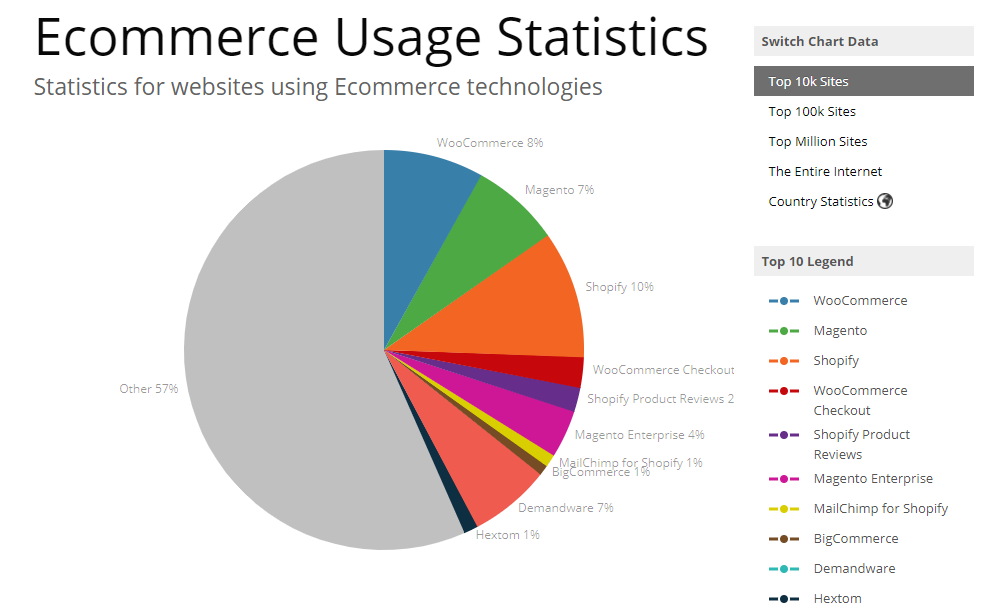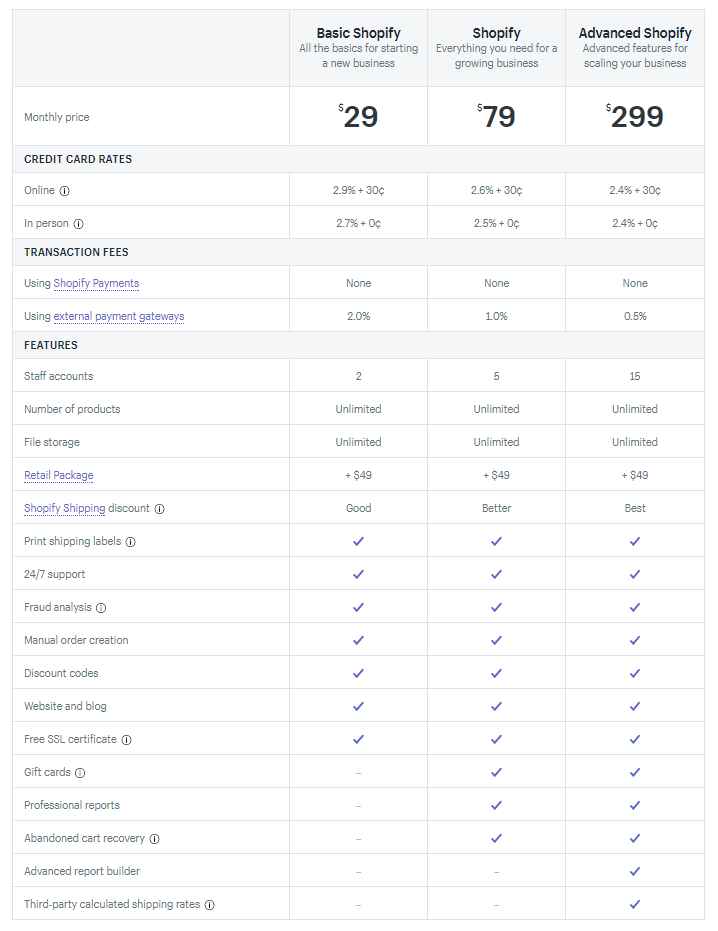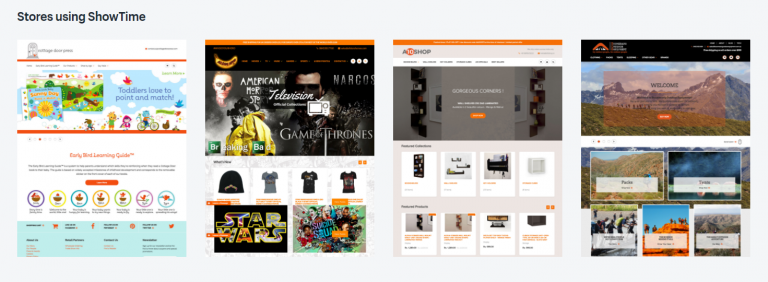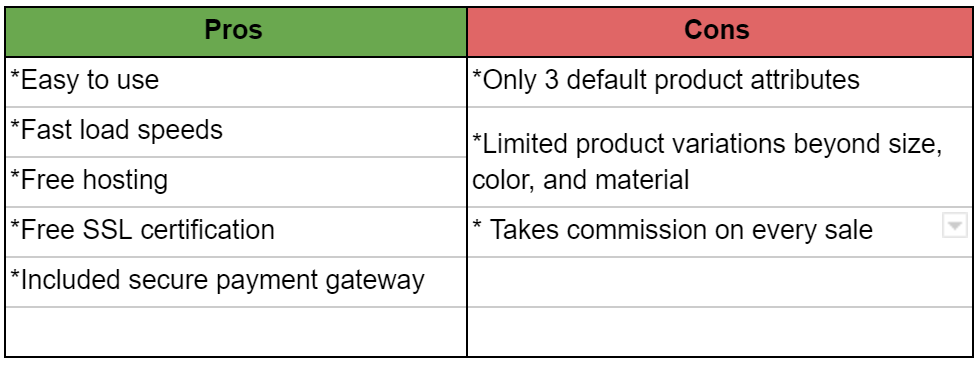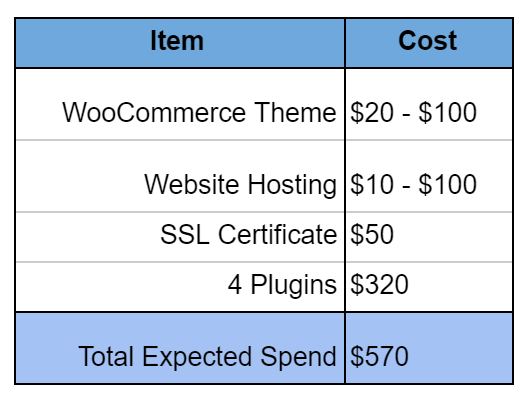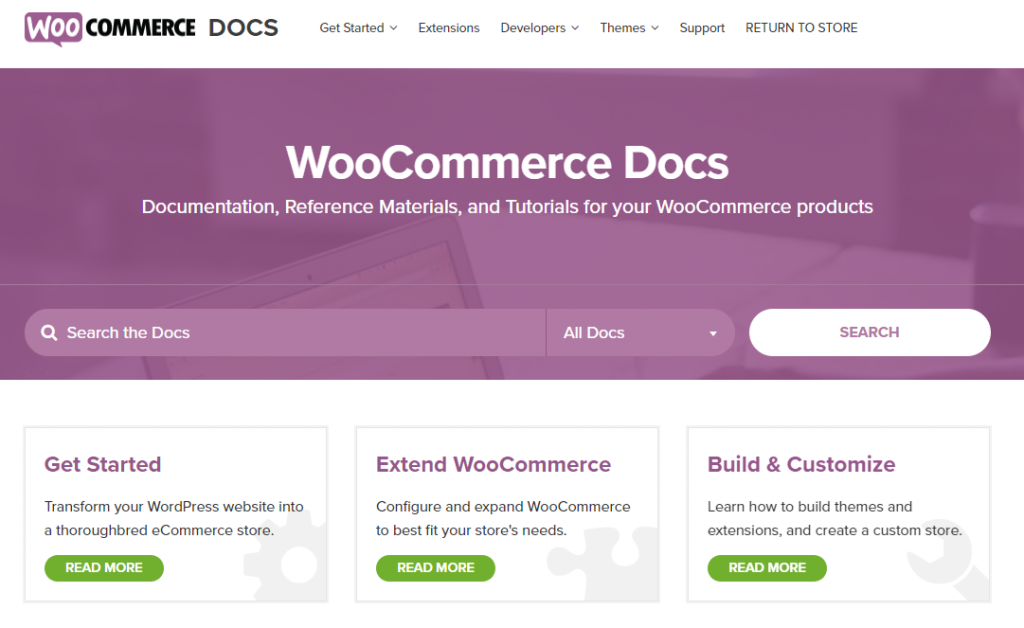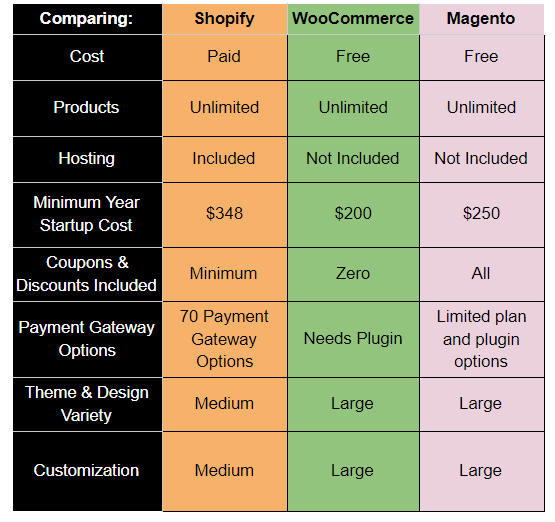One of the biggest struggles new eCommerce entrepreneurs have is choosing the right platform to launch their business. Choosing the right platform from the get-go ensures you are able to scale your business as seamlessly as possible, and having to change platforms after the fact can cost you tens of thousands of dollars.
So where to start?
The three most popular of these eCommerce platforms, and the ones you’re likely to choose from are: Shopify, WooCommerce and Magento. In this guide we will take a deep look at each platform, the pros and cons of each and give you all the information you need to help you choose the right eCommerce platform for your business.
[Source]
Choosing between them will ultimately be based on three things:
- Your budget. Not just how much money you have to spend on hosting, creating and stocking your stores but also how much you’re willing to pay to get specialist help where needed and for monthly upkeep.
- Your Store. Next, think about your store vision: How many products you have, how you envision scaling your business in the first, second, third year and so on.
- Play to your strengths. What will be easier to use? As a new store owner with minimal budget, you need the platform to be as user-friendly for you as possible. For example, I prefer the freedom a downloadable gives me and I like learning new tech how-to’s. Whereas someone else may find the learning process too time consuming and difficult, taking away too much time from other skills such as product creation or marketing.
But before we can choose based on these three things, we need to understand each of these platforms, what their pros and cons are and be able to match it to our business needs, budget restrictions and our personal skills.
Let’s dive in, by breaking eCommerce platforms into their two groups…
Hosted Vs Downloadables
The first thing to understand is that there are two major types of platforms: hosted and downloadable platforms.
Hosted eCommerce Platforms:
Also known as SaaS platforms, these are easy-to-use eCommerce platforms that enable those of us without a deep programing knowledge to set up sites in a matter of minutes. They include platforms such as Shopify, and come ready-built with payment platforms, security certificates, functionality, hosting etc. Think of them as an all-for-one product that allows you to increase features and functions though apps.
Downloadables eCommerce Platforms:
Also known as open source or self-hosted, these platforms are for those who are a little more tech savvy and want more control. These platforms – such as Magento and Woocommerce – mean you need to source and maintain your own hosting services and allow you to either download ready-made templates that you can tweak, or if you have the budget for programmers and designers, build the whole site from scratch.
And now, your guide on how to choose the right platform between Shopify, WooCommerce and Magento.
Shopify, WooCommerce & Magento
Here’s the lowdown on the three leading eCommerce platforms: Shopify, WooCommerce and Magento:
Shopify eCommerce Platform
Shopify is the most popular hosted eCommerce platform that provides built-in hosting, payment gateways and an easy interface that has a host of add-on features you can invest in as your store grows. Their themes range from free to around $180 dollars and include features like:
- Detailed reports and analytics
- Easy social media and email marketing integration
- Mobile-friendly responsive designs
- Easy interface and full blog facilities
Shopify Costs
Shopify comes with a 14-day free trial that will allow you to give it a try before you invest. Its price then starts from $29 per month for the basic plan and extends to $299 for the advanced. Here is a table of cost vs functions from Shopify:
Regardless of which plan you choose you’re guaranteed a site blog, unlimited products and bandwidth, and SSL certification. Another cost to consider are the store themes. Shopify offers free and paid themes, all including the bare essentials of what you need to immediately launch a live, good-looking, functioning store. As far as domains go, you can either buy your domain separate and link it to your Shopify store, or buy one through Shopify starting from $9.
To sum up, as a starting cost, you will need a minimum of $30 per month and up to around $200 upfront for your theme and domain.
Shopify Selling
Shopify is incredibly user-friendly and its selection of free features means you are able to start selling for very minimum budget. As your store grows, you are able to fine-tune your selling process with a variety of add-ons and apps, such as email integration, pop-ups, coupons, traffic boosters, delivery tracking and more.
Shopify Design Options
There are a wide variety of store theme options that will help you create the store you have envisioned. Themes range from $0 to $180, and there are a variety of platforms such as Storetasker, agencies and experts that you can hire to tweak your store as your store grows if needed.
Bonus: How to Choose the Best Shopify Theme for Your Online Store
Shopify SEO
Shopify stores include automatically generated XML sitemaps and uses titles and meta tags to help make your store SEO-friendly. Additionally, the fast loading time of pages, image optimization and SSL certification, all contribute to ensuring your Shopify store is SEO optimized.
Shopify Support
Shopify has pages and pages of help documentation on a variety of issues ranging from setting up your store to improving your functionality. Shopify store owners also have access to a dedicated support team who are available 24-hours-a day, 7-days-a-week. If you’re looking for further community support, there are hundreds of platforms and resources out there such as one of the top 31 Facebook groups, “Shopify eCommerce Group.”
Shopify Pros & Cons
Shopify’s biggest advantage is that from day one you will have access to basic features and reports included in the price and therefore can have your store up and running with your first product immediately — all for a very low monthly price. Its biggest disadvantage, though, is that you have less customizable options and that the data is not your own.
Some other pros and some cons of using Shopify eCommerce platform include:
WooCommerce eCommerce Platform
WooCommerce is a open source (or downloadable) eCommerce platform that turns your WordPress site into an eCommerce store. This plugin is free and will turn your theme into an online store that integrates seamlessly. This platform is suited for those eCommerce entrepreneurs who are a little more tech-minded and want more than a drag-and-drop dashboard or for those wanting to turn their existing WordPress site into the online store they have been dreaming of. Some winning features of WooCommerce include:
- Payment gateway variety
- Sales, inventory, reviews and performance reports
- Integrated reviews and discount options
- Shipping and tax
- Product variety across physical goods and downloadables
WooCommerce Costs
The WooCommerce plugin is free to download. However, you will need your domain, hosting and theme paid for, and your monthly costs will be determined by your hosting and domain costs plus you will need to invest in SSL, where you are looking at around $50 per year. That means a minimum of $30 -$99 for an advanced theme. Plus, there are certain paid add-ons such as PayPal, Stripe, SEO, and shipping such as FDX that you should expect to invest into give your store the functionality you need for maximum success. These are often free to download, but come with monthly subscription costs that can cost around $80 a year on average each.
Here’s a rough breakdown of what you would need up front to start your WooCommerce online store:
Selling With WooCommerce
By downloading free WooCommerce you will already have access to their core features that have enough functionality to get you selling right away. However, you should budget for addons and plugins as you grow to increase store functionality, marketing, traffic and shipment flows, all designed to make selling more effective and easier.
WooCommerce Design Options
You won’t find a shortage of WordPress themes that are already optimized for WooCommerce. From WooCommerce itself you have access to Storefront, their intuitive and flexible, free WordPress theme that offers deep integration with WooCommerce. It works similar to Shopify in the sense that you get free functionality with the ability to add paid extensions as you build your business.
Alternatively, you also have access to hundreds of good quality WordPress themes already WooCommerce-integrated on theme markets such as Themeforest.
Like with Shopify, if you have the budget you can also outsource designers and programmers to tweak your theme look and coding or to create a theme designed specifically for your store.
WooCommerce SEO
As WooCommerce is essentially a WordPress plugin, it is already SEO-ready and with the help of free and paid apps like Yoast for example, you can improve your SEO easily and ensure your content, product pages and site is always 100% optimized.
WooCommerce Support
There is no shortage of online WooCommerce committees and documentations to answer any questions you may have.
If you do need to contact them you can do so via ticket submission or through their online chat. You can read their full Support Terms and Conditions here.
WooCommerce Pros & Cons
WooCommerce’s biggest advantage is that it can be incorporated into a site you already have, for free and its vast customizability. Its biggest disadvantage is that a lot of functions will need to be added individually for a cost and some tech know-how is needed.
Some other pros and some cons of using WooCommerce eCommerce plugin include:
Magento eCommerce Platform
Like WooCommerce, Magento is also an open source eCommerce platform that provides unlimited customization options. This platform is for new medium-to-large online stores that are looking for maximum flexibility and scalability, tailored specifically for development professionals. It isn’t ideal for those wanting to dip a little toe into the world of online shopping as the outlay is quite substantial. Some winning features of Magento include:
- Intuitive admin interfaces
- Unique layout and theme system
- Unlimited product variations
- Built-in API for third-party connections
- Ability to add multiple stores to one platform
Magento Costs
As we mentioned, Magento is not for those beginners bootstrapping their store on a small budget as it is the most expensive of these three platforms. Instead, this option is for companies who are moving from a hosted platforms or starting up and the costs reflect that. Costs include hosting, development costs (as this platform requires a lot of tech know-how), plugins or addons ranging from $0 – $500 per plugin, and a licensing fee for larger enterprises. In short you could be looking at $50k per year, depending on your store’s revenue. However, Magento does offer a 30-day free trial that will enable you to test their platform before you outlay any money.
Selling With Magento
Selling with Magento takes time. You’re looking at up to six months of development before your site will be ready for advanced stores or 2-4 weeks when using themes with minimum development. However, Magento is the most flexible of platforms and selling as your store grows and your needs change make it highly customizable.
Magento Design Options
Also like WooCommerce, Magento offers thousands of free to paid online store themes. Magento however offers a lot more free template options that you can then customize with development help as you see fit.
Magento SEO
When it comes to SEO, Magento is on par with its competitors, however it has been known to have a few issues that will need some extra work on your end. Yoast has a great how-to guide full of suggested tips to improve the SEO of your Magento site.
Magento Support
Magento support comes from either agencies or developers and the amount of availability depends on what tier you’ve signed up for. You can download their full support guide here.
Magento Pros & Cons
Magento’s biggest advantage is that it’s customizable, allowing you to create a unique store with endless possibilities, even allowing you to manage more than one store at a time. It’s biggest disadvantage, however, is the cost.
Some other pros and some cons of using Magento eCommerce plugin include:
Shopify vs. WooCommerce vs. Magento
How do these eCommerce platforms compare? The best way to assess each is to look at functionality, customization and support. Here’s a breakdown of each.
eCommerce Platform Functionality
By functionality, I am referring to the amount of function you get out-of-the box before using an add-on or extension. The winning platform here would be Magento, however the cost for that function is very high. If you’re looking for the most amount of function for your money, you’re looking at free WooCommerce. If you’re looking for the best function for your buck without having to install any addons, then Shopify is your winner.
eCommerce Platform Customization
For the most customization you’ll want WooCommerce or Magento – offering a host of PHP or CS functions allowing you to make any theme you use unique. Shopify offers the least customization, but if you find a theme that fits your needs, this diminishes your costs substantially.
eCommerce Platform Support
Winning for the most helpful and cheap support, is Shopify. Shopify offers a customer support team and a community of users online to help. While WooCommerce offers the biggest online community of users and support documents, and Magento enterprise package comes with 24/7 support.
Here’s a quick summary table to compare these three eCommerce platforms.
As I said, choosing between these should be based on:
- Your budget…Do you want to limit your monthly spending or to start off free and add functionality and spend as you grow?
- Your skill… Do you have enough tech know-how to choose more customization
- Your Store… How much flexibility will you need in your product types and display?
One you know how each of these platforms compare and what your needs are, your choice becomes a little easier. To help you even further, here’s a guide to help you through it.
Pro Tip:
If you’re still struggling between the platforms, and don’t have an unlimited budget for designers to tweak and code, reverse engineer your goals. Look at the various themes available to you using these platforms and find the one that matches your vision for your online store in way of design, functionality, cost and ease-of-use to you.
Conclusion: How to Choose the Right Platform Between Shopify, Woocommerce or Magento.
Ultimately your decision should be a very personal one, based on your specific store needs and your eCommerce vision. If you’re new to eCommerce with very little budget, you may want to choose something with the least amount of outlay to get you selling and testing for less, with WooCommerce or Magento. If you’re someone who wants hassle-free setup with minimum effort or customization, then the Shopify basic plan of $29 per month is a great start. Here is a step-by-step on helping you make your choice:
Step 1: Review design and theme options
Step 2: Compare inventory management
Step 3: Review plans and pricing
Step 4: Compare support options
Step 5: Choose your platform and welcome yourself to the eCommerce world
I will leave you with this infographic from MadeByTribe.co to sum up everything we discussed in this post. If you have something to add or still need help choosing your platform feel free to comment below and we’ll help you further on your eCommerce entrepreneur journey.

Nicole is a content writer with over sixteen years experience and flair for storytelling. She runs on a healthy dose of caffeine and enthusiasm. When she's not researching the next content trend or creating business content strategies, she's an avid beachgoer, coffee shop junkie and hangs out on LinkedIn.
Recommended articles
 Facebook Ads for eCommerce: 16 Strategies, Examples & Tips
Facebook Ads for eCommerce: 16 Strategies, Examples & Tips
 How to Build a Winning eCommerce Ads Strategy
How to Build a Winning eCommerce Ads Strategy
 Google Ads for eCommerce: Everything You Need to Know
Google Ads for eCommerce: Everything You Need to Know
 10X Your Traffic with PPC Management Software
10X Your Traffic with PPC Management Software
Comments
Powered by Facebook Comments
